GOURMET COMPOST FOR ALL
Your Pet Needs:
As the bumper sticker on my truck reads, “COMPOST HAPPENS.” Even so, problems sometimes arise along the way.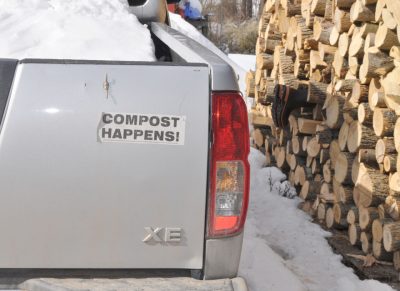
Is your main complaint that your compost “happens,” but too slowly. I like to picture my compost pile as a pet, except this pet is made up of many different kinds of macro- and microorganisms, and the population changes over time. Like other pets, my compost pet and your compost pet need food, air, and water.
Compost piles work quickest when their two most important foodstuffs — nitrogen and carbon — are in balance. (All this, by the way, also applies to us humans; our nitrogen comes mostly from proteins, and our carbon comes mostly from carbohydrates.) Old, usually brown and dry plant materials, such as autumn leaves, straw, hay, and sawdust, are the carbon-rich foods for a compost pile.  The older the plant material, the richer it is in carbon. Nitrogen-rich materials include young, green plant parts, such as tomato stalks, vegetable waste from the kitchen, and grass clippings, as well as manures.
The older the plant material, the richer it is in carbon. Nitrogen-rich materials include young, green plant parts, such as tomato stalks, vegetable waste from the kitchen, and grass clippings, as well as manures.
Nitrogen fertilizers are concentrated sources of nitrogen. They commonly are the active ingredients of commercially available compost “activators.” “Activator” has a nice ring to it, but it is overpriced, unnecessary, candy for any compost. Sometimes they also contain microorganisms, also unnecessary.
A Balanced Diet, and “Chewing”
Now is the time of year when compostable materials rich in carbon are spilling over in excess from our gardens and yards, so the way to speed up compost piles built now is by looking for nitrogen-rich materials to balance out that excess. You can read about the ratios of these materials to use for your compost (in, for example, the detailed section about composting in Weedless Gardening), but don’t sweat it too seriously. Microorganisms will eventually balance out an excess of one or the other all by themselves, albeit slowly if the excess is of carbon foods.
Attempts to be too precise also are unfeasible, because other factors come into play, such as actual carbon and nitrogen concentrations and particle sizes of the raw materials. And certain compounds in the raw materials, such as lignins, carbon-nitrogen ratios notwithstanding, are only slowly digestible by compost creatures.
Changing particle sizes is a feasible way to speed up composting: Shredding or chopping the raw materials gives microorganisms more initial surface area at which to “chew” away. When I started gardening, I went out and bought a gasoline-powered shredder. I soon realized that the chugging noise and fumes spewing from the engine were not in line with the bucolic experience I expected from gardening, not to mention all the environmental benefits from growing my own tomatoes, lettuce and other vegetables.
That shredder has long been replaced by a machete, a convenient tool for chopping coarse materials, everything from corn and broccoli stalks to a springy layer of bean plants. It doesn’t leave materials uniformly fine, but it’s trouble-free and solar-powered. I keep it stuck in the ground near my compost pile where it takes up little storage space, and needs no more maintenance than an occasional filing of the blade.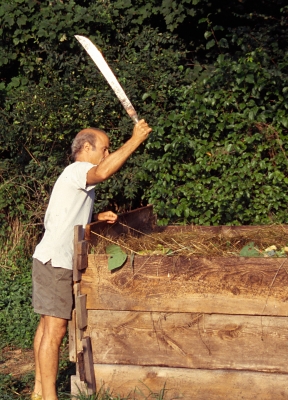
Quenching Thirst
A thirsty pet is another frequent cause for sluggish compost. Sun and wind dry out piles that are free-standing or enclosed by wire mesh or wooden pallets. A solid-walled enclosure not only helps speed things along by holding in moisture, but also holds in generated warmth so decomposition can continue even as outdoor temperatures cool. Carbon-rich materials are often naturally dry, making water within the growing compost pile limiting.
The cure for insufficient moisture is, of course, to add water, and the most effective way to do this is to layer raw materials, watering each layer as you build just enough to make the surfaces glisten. It takes a long time to get enough water deep into a dry pile.
I’m not patient enough to stand there with a hose so I build up a few layers and then water with a simple, inexpensive sprinkling system I rigged up. The water first runs through a pressure reducer, which maintains constant pressure, and valve, both of which are available from suppliers of drip irrigation components.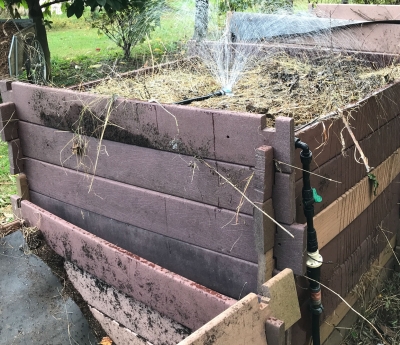 I turn on the water and adjust the valve so water from the sprinkler is conserved, spreading no further than the edge of the pile. Twenty minutes of sprinkling seems to quench a pile’s thirst, which I confirm by sliding the long stem of a similarly inexpensive, long-stemmed, electronic moisture probe into the pile.
I turn on the water and adjust the valve so water from the sprinkler is conserved, spreading no further than the edge of the pile. Twenty minutes of sprinkling seems to quench a pile’s thirst, which I confirm by sliding the long stem of a similarly inexpensive, long-stemmed, electronic moisture probe into the pile.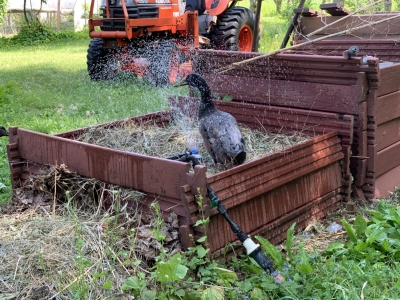
The opposite condition, too much water, can also slow composting. And soggy ingredients lead to yet another common composting problem, that of the pile giving off offensive odors or attracting flies. When too much water gets into a compost pile, air is displaced and a whole new set of microorganisms go to work, ones that work slowly and malodorously.
Odors due to poor aeration result from piles built with an excess of dense, succulent raw materials, such as grass clippings or kitchen wastes. With either of these materials, the odor problem is compounded because they’re so rich in nitrogen, some excess of which is vented off as ammonia gas. The problem of excess nitrogen is, obviously, most easily avoided if carbon-rich materials come along to combine with the nitrogen.
The cure for a waterlogged pile is aeration, accomplished by either stirring the pile, or turning and rebuilding it. Rotating drum bins make it especially easy to stir ingredients. My bin, made of boards notched to stack like Lincoln Logs, also make turning easy because the sides go down and up as I remove or add ingredients.
For a pile already stacked high, turning it while adding some fluffy, high carbon material, such as straw, puts everything in order. Some gardeners build their compost bins out of straw bales. As the bales disintegrate, the straw is conveniently available to balance out nitrogen-rich materials in subsequent piles.
What’s the Rush?
When building my compost piles, I try to balance the foods as far as carbon and nitrogen and aeration. All this changes through the year as different materials become available. Once a pile is about four feet high and is well fed and neither thirsty nor gasping for air, I like to keep it that way while “cooking,” so I cover the top to seal in moisture and keep out excess water from rainfall, using EPDM roofing material.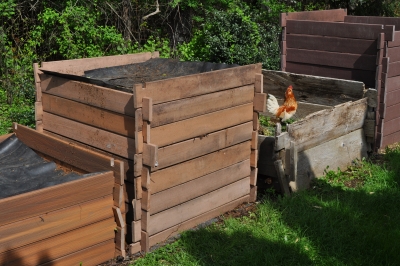
Monitoring compost progress beyond what my nose or time will tell lets me make adjustments to an existing pile or what to do differently next time. I slide the long probe of a compost thermometer deep within a pile’s innards. Temperatures within a pile that is at least 27 cubic feet and built over the course of a few days can quickly soar to 140 degrees F., or higher. No heat indicates insufficient moisture, nitrogen, or air, or too small a pile.
Piles built slowly or in winter also generate little or no heat.
But compost happens. Whether progress is fast or slow, any pile of living or once-living materials will eventually turn to compost, and a few benchmarks signal just when. Take the pile’s temperature. Heat will no longer be generated. Look at the compost. Most raw materials will have been transmuted into a dark brown, crumbly fudge. Smell it. Finished compost has a pleasant, woodsy aroma. Mmmmm.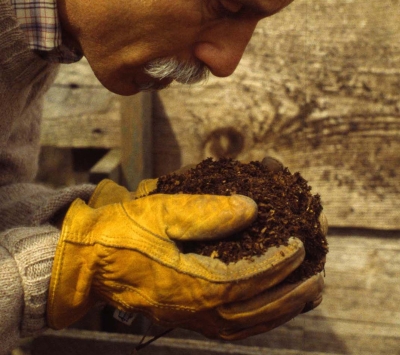


May I forward this article to the other plot holders in my community garden in Morristown, NJ ? We have just under 120 plots. But fewer people because many have multiple plots. We have a very nice three bin system built by boy scouts and last year I did several demonstrations but it is hard to have a group “get it”
perhaps because we do not think of it as a group pet? I will not forward it to the group unless you give permission although I have forwarded other of your articles to individual people.
I’mm not sure what “forwarding” is in this context. You could just give them the link. But most satisfying to me is to have people read what I write, so anyway you want to get them the article is fine with me. Thanks.
This was very helpful, thank you Lee! Right now my compost is being held together by chicken wire, but now I think I’ll try and construct something out of wood pallets. But the good news is that think I’ve successfully (and unintentionally) added a great balance of nitrogen and carbon rich ingredients!
Glad my post will help you to make even better compost.
Great info on your blogs. Are the wood boards for your compost bins with stacking cuts from a chain store or can they be made? BTW I was inspired from your talk on GAGW and am planning to grow many fruit trees and bushes on our acre.
Glad you find my posts useful. I cut the “wood” for my compost bins from longer lengths, and then notched them.
I love your compost bin design! Thanks for sharing. I’m inspired 🙂
It’s very simple. Each board is about 4 feet long and has 4 notches, 2 on opposite sides 3 inches from each end. Each notch is 1/4 the width of the board and slightly wider that the thickness of the board. I ripped one of the boards lengthwise to create two half-width boards for the bottom of the bin.
…do you have a design plan available anywhere for you compost box construction?
Thank you
It’s very simple. Each board is about 4 feet long and has 4 notches, 2 on opposite sides 3 inches from each end. Each notch is 1/4 the width of the board and slightly wider that the thickness of the board. I ripped one of the boards lengthwise to create two half-width boards for the bottom of the bin.
Hey Lee, I am in mid-Michigan, and have been hearing from fellow gardeners that they are struggling with high pH (upper 7’s) from the compost they are putting on their garden. They are using compost from a landscape company, so I’m not sure how to speak about the quality of the compost – I believe it’s largely leaf-based. The other thing I’ve heard is that our bedrock in this region is largely limestone, making our soils prone to high alkalinity. Do these accounts make sense? I’ve generally operated under the assumption that adding compost (including landscape-supply compost) will be fine and any pH imbalance would eventually even out as the compost ages in the garden. However, that doesn’t seem to be happening in these gardeners experience – they are saying that the pH is remaining high, causing issues in the microcritters ability to make nitrogen available to plants.
The high pH is probably due to your limestone bedrock. I wouldn’t worry about the pH because the high 7’s is not all that high. Keep using the compost.